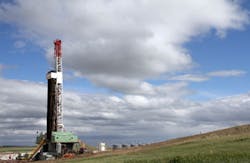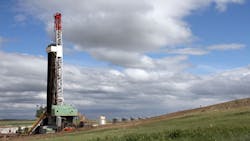EIA report revises global shale oil and gas reserves upwards
Global reserves of shale-based resources push up the world's total potential oil reserves by 11 percent and natural gas reserves by 47 percent, according to new estimates from the U.S. Energy Information Agency (EIA).
A preliminary assessment of shale oil resources worldwide and an update of shale gas reserves across the globe has suggested that shale deposits could add 345 billion barrels of oil to global reserves, resulting in a total of 3,357 billion barrels. Meanwhile, shale gas could add 7,299 trillion cubic feet of natural gas, or 32 percent of the world's total, the EIA report said.
In its report the agency seeks to find out the potential impact of the shale boom on a global scale, following the revolution of the U.S. oil and gas industry after the rapid development of North American shale deposits. The EIA stated that a better understanding of geological data has led to a general upward revision of global resource estimates.
The report noted that outside the United States a number of countries have significant shale resources, including Russia, China, Argentina, Algeria and Libya. However, the agency pointed out that the estimates could be highly uncertain and approximate. The actual volume of deposits could be more accurately estimated only by testing production wells, the EIA said.
The report builds on a 2011 EIA report on natural gas resources, increasing the estimated global quantity of shale gas by 10.2 percent. The global potential of shale oil was not included in the report from two years ago, the agency explained.
RELATED: GE to invest billions to improve fracking
The EIA did not look into the economic viability of developing the resources because this could vary from country to country and because of the numerous factors that could play a role in analyzing this. For instance, the cost of wells internationally could be higher than in the United States, which might mean that drilling wells would be irrelevant under the current market conditions. At present, only the United States and Canada have been able to produce shale energy in commercial quantities.
It is worth noting that not all revised data led to a rise in estimates. Estimates for China were reduced to 1.1 trillion cubic feet of gas from 1.3 trillion cubic feet in 2011, after better data revealed the size of key hydrocarbon fields and their total organic content. The EIA estimated that China had the world's greatest recoverable shale resources and the third-largest shale oil resources.
According to the EIA, recent drilling in Argentina, Mexico and Poland has helped to deliver more information on global resources. The six countries that have the biggest recoverable shale gas resources — China, Argentina, Algeria, the United States, Canada and Mexico — account for nearly two-thirds of the world's recoverable shale gas. Meanwhile, Russia, the United States, China, Argentina and Libya account for roughly the same proportion of the global recoverable shale oil. The agency did not assess shale formations in some regions, such as the Middle East and the Caspian region.

